
Week 16 Walkthrough: Sonic Boom
Welcome to the Week 16 Walkthrough.
In this article, I'll outline critical fantasy football context for the 16th glorious football Sunday.
(The stats below are from PFF, NFLfastR, rbsdm.com, RotoViz, FantasyLabs, Fantasy Points, ESPN, and NFL Next Gen).
Subscribers can view the PROE data in a sheet at the bottom of the post.
Quick Links
- Texans at Chiefs, 1 PM, Saturday
- Steelers at Ravens, 4:30 PM, Saturday
- Lions at Bears, 1 PM
- Browns at Bengals, 1 PM
- Eagles at Commanders, 1 PM
- Rams at Jets, 1 PM
- Cardinals at Panthers, 1 PM
- Giants at Falcons, 1 PM
- Titans at Colts, 1 PM
- Vikings at Seahawks, 4:05 PM
- Patriots at Bills, 4:25 PM
- Jaguars at Raiders, 4:25 PM
- 49ers at Dolphins, 4:25 PM
Texans at Chiefs, 1 PM, Saturday
Texans Implied Team Total: 19
Heading into last week, I saw some potential for the Texans' passing offense. C.J. Stroud was facing a vulnerable Dolphins secondary, and Bobby Slowik had also shown a surprising willingness to air it out over a multi-week stretch.
To his credit, Slowik certainly held up his end of the bargain. For the fourth straight game, the Texans were legitimately aggressive, both overall and on 1st down.

This led to a virile 69% pass rate.

Unfortunately, Stroud turned in his least efficient game of the season, with a disastrous sixth-percentile mark in EPA per play.

This continues a deeply disappointing sophomore campaign from Stroud.
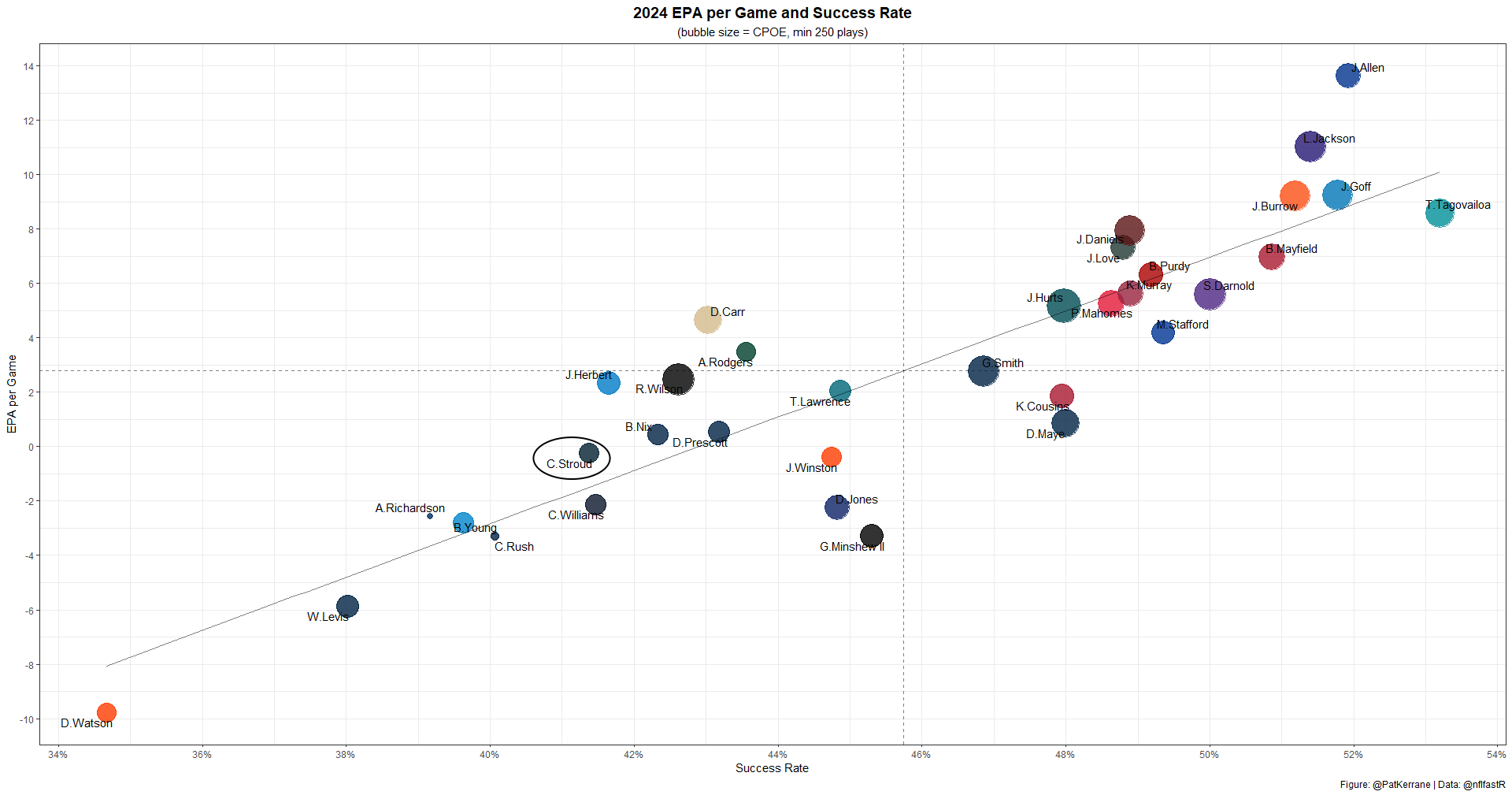
Last week, Stroud was not impressive from a clean pocket. In EPA per clean dropback, he was QB21 on the week. But he was downright putrid under pressure, ranking QB27—with a mark that was easily his worst of the season.
Stroud was pressured on only nine dropbacks, but he managed just 4.8 yards per attempt – while glaringly surrendering four sacks.
Stroud’s issues with pressure are a major concern, because the Texans cannot be counted on to protect him.
The Chiefs’ pass rush is merely middling, but this Texans pass protection unit is a legitimate liability.

The Chiefs will also create issues in coverage. Nico Collins has seen an inordinate amount of double coverage this year, including an outrageous 57% rate last week. No WR has been double-covered at a higher rate this season.
With the Chiefs also leading the NFL in double-team rate, Collins is going to have to be at the top of his game to draw targets.
But Collins is hard to take away. He has a 2.75 YPRR against double coverage, which would be an elite mark overall.
Still, he’s at 3.31 YPRR when not doubled (trailing only A.J. Brown at 3.74). So more single coverage would be welcome.
In the end, this matchup presents a genuine challenge. But Collins is a bona fide superstar. He’s a WR1.

Tank Dell has just three catches for 49 yards over his last two games, and has not been impressive this year. He’s a WR4.
Dalton Schultz is a good bet for routes, with 91% route participation against the Dolphins. But his efficiency continues to be very unimpressive. He’s a TE2.

With Stroud struggling, it’d be logical for the Texans to shift back to the run this week. But they’re facing a stout Chiefs run defense that will make that harder to pull off.

Still, Slowik’s recent commitment to the pass has been pretty out of character, based on how he called plays last year. We could see him go more conservative, especially if Patrick Mahomes is at all limited.
And even if Slowik is now a true believer in this “forward pass” thing, Joe Mixon has shown he can thrive in a pass-heavy game environment. He’s a locked-in RB1.

Chiefs Implied Team Total: 23
Patrick Mahomes is reportedly good to go after suffering an ankle sprain last week. And while Mahomes hasn’t been peak Mahomes this year, he’s still a much better option for the Chiefs than Carson Wentz.

Unfortunately, this is not the type of matchup where you can expect to hide a hobbled QB. The Texans have an elite pass defense.

As I explored extensively last week, the Chiefs have already been getting the ball out quickly on shallow passes—with Mahomes at full health. With Mahomes about to face an elite pass rush – and now nursing an ankle injury – expect a very conservative passing game.

We could also be looking at one of Mahomes’ least efficient games of the year, which, considering his performances thus far is saying something.

Normally, I would expect passing volume to be on our side—the Chiefs have now been aggressive for six consecutive weeks.
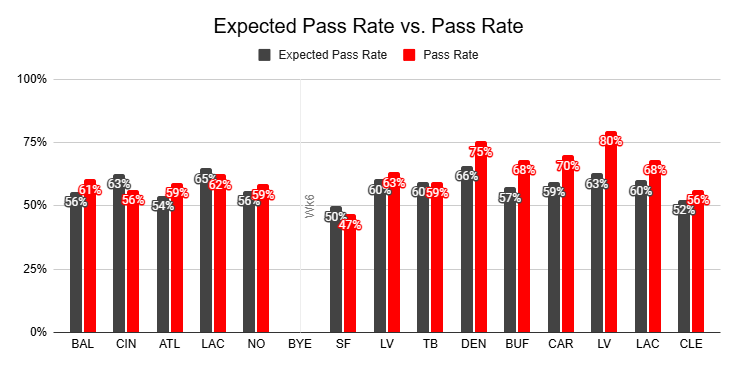
But given the situation, it would make a lot of sense for the Chiefs to pivot to the run and limit Mahomes’ dropbacks. And while the Texans are good against the run, they aren’t as dominant as they are against the pass.

If the Chiefs had a clear lead RB, this would make for a decent volume-based setup. But the Chiefs gave Isiah Pacheco just 37% of snaps last week, with Pacheco and Kareem Hunt both seeing 13 attempts.
Hunt’s reemergence doesn’t make a ton of sense to me. He’s been quite poor this year, totaling -94 RYOE, and he's pairing that with a poor success rate of 35%.

Pacheco has been better, with 9 RYOE, and is the incumbent. But since returning from injury, he hasn’t even approached a full-time role.

I don’t expect Pacheco to take control of the backfield this week, but given the potential for substantial added volume, there’s upside for a strong workload anyway. Pacheco is a high-end RB3.
The Chiefs are continuing to split playing time at WR as well, with DeAndre Hopkins seeing just 49% route participation against the Browns. As usual, Hopkins was targeted on a high percentage of those routes, but he looks stuck in a part-time role for now. That could change, but it’s unlikely to be before the playoffs. He’s a WR4.

Xavier Worthy is coming off 11 targets on 86% route participation, and it’s possible the Chiefs have some quick-hitting passes or runs planned for the speedster this week. He’s also a WR4.
Travis Kelce turned in just a 4/27/0 receiving line last week, but he posted an elite 91% route participation, drawing eight targets. He’s been Mahomes’ underneath safety blanket all year, and is a safe bet for targets. He’s a locked-in TE1.

Back to Quick Links
Steelers at Ravens, 4:30 PM, Saturday
Steelers Implied Team Total: 19
Over the last few weeks, I’ve noted that Russell Wilson has been profiling as a negative regression candidate—his success rate was far lower than you’d expect for his EPA efficiency.
We got that negative regression against the Eagles.

Wilson still looks a bit like a negative regression candidate, although his profile is far less glaring.

More importantly, Wilson moves from an impressive Eagles defense to one of the softest pass defenses in the NFL.

Although when Wilson faced the Ravens in Week 11, he struggled. So it’s not like efficiency is guaranteed here.
One issue for Wilson is that the Ravens are actually very good against the run.

Frequently, the combination of a good run defense and a bad pass defense is good for the opposing QB. Many offenses will pivot to the pass in that scenario, setting their signal caller up for a productive day.
But the Steelers play a very specific type of football—one that relies on establishing it.
In Week 11, the Steelers were able to stifle the Ravens on offense, creating a run-heavy game script for themselves. They happily played to that script.
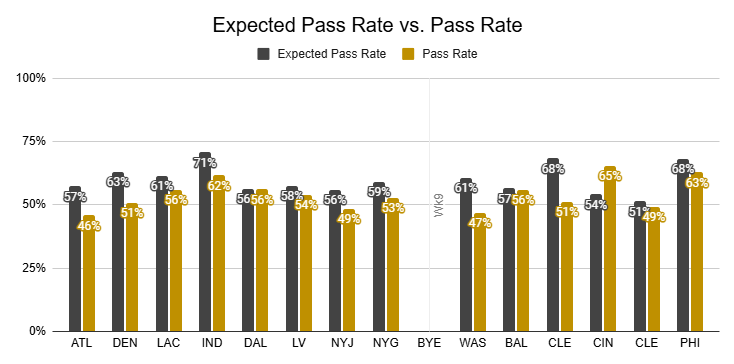
The Steelers would undoubtedly prefer a similar setup in this rematch. But we would prefer that the Ravens push them. Against the Bengals, the Steelers showed a willingness to air it out. And if they let Wilson take chances against this defense, he should be more successful than last time.
Wilson’s chances of a truly impressive outing take a big hit without George Pickens. Pickens has missed the last two games with a hamstring injury will be out this week as well. His absence has been significant.

With Pickens out, the Steelers have been leaning on Calvin Austin and Van Jefferson – which has been going about as well as you’d expect.

Pat Freiermuth got in the end zone last week, but it was on just three receptions for 22 yards. He gets a boost from this matchup, but is still just a TE2.

It would be really nice if the Ravens can push the Steelers off the run. Because when they go against a strong run defense, it can get ugly. Last week, Najee Harris turned six carries into just 14 yards, for -9 RYOE. Jaylen Warren was just as bad, turning four attempts into 12 yards, with -6 RYOE.
The inefficiency was combined with a split workload. For the second-straight week, Warren managed a small majority of snaps.

If the Steelers need to pass here, Warren has some appeal as an RB3. But he’s not playing well enough to be exciting.

Harris is more likely to lead the way on the ground, and isn’t a zero as a receiver. He remains a slightly better bet than Warren, and is also an RB3.

Ravens Implied Team Total: 25.5
Last week, the Ravens went against a Giants defense that really had no hope of stopping them. And they faced a Giants offense that had no hope of an efficient passing day, even against a weak Baltimore pass defense. It was the type of setup where the Ravens were highly unlikely to air it out, and… they didn’t.

Looking exclusively at the Ravens pass rate and PROE, last week looks like a typically run-heavy showing from the Ravens in positive game script. They were even run-heavy on 1st-and-10.
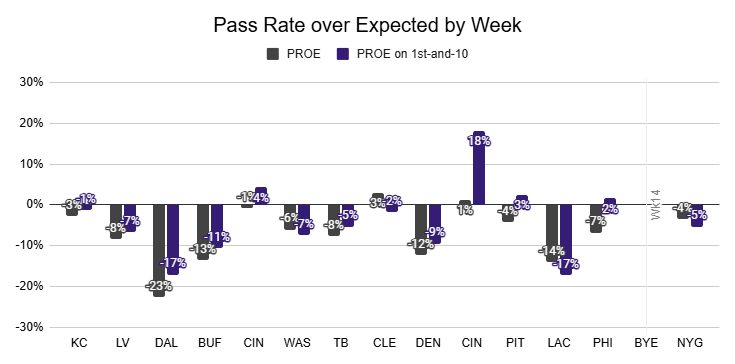
The reason it didn’t feel that way is that Lamar Jackson turned in elite efficiency. On just 28 dropbacks, he delivered 290 yards and five TDs. It was reminiscent of Jared Goff’s performance against the Jaguars, when he posted 412 yards and four TDs on 29 dropbacks.
And we know that Jackson is capable of that type of efficiency. He’s been even better this year than last year. If not for the existence of Josh Allen, we’d be talking about a back-to-back MVP.
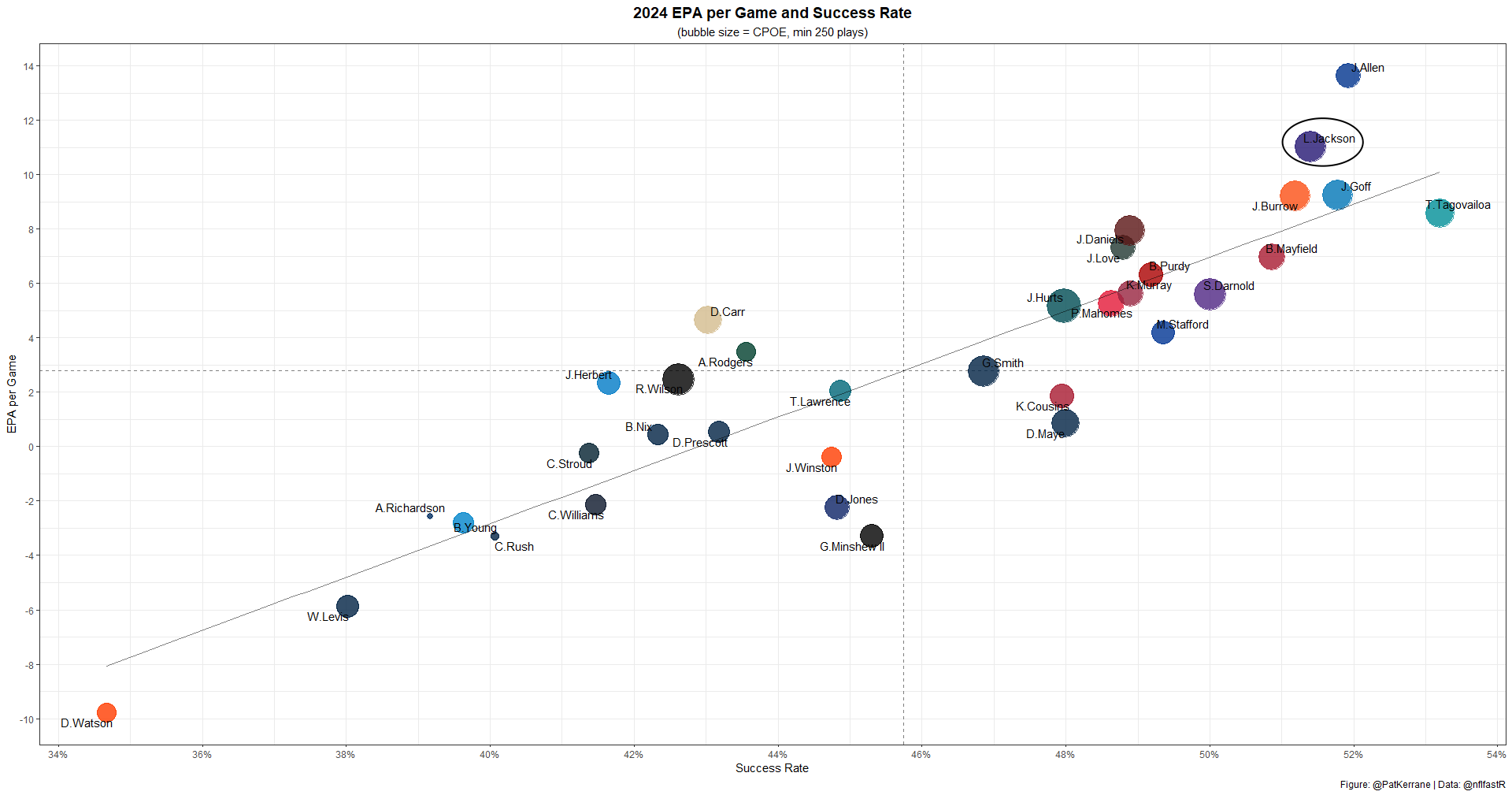
The point here is that last week didn’t reveal anything new about the Ravens. In a spot where we'd expect them to lean on the run... they leaned on the run. But their all-world QB had an all-world passing performance.
This week, Jackson gets a Steelers defense that is very solid – and that he struggled against in Week 11.

But the Steelers aren’t a shutdown pass defense. They’re good, but Jackson struggled against them far more than we’d expect at baseline.
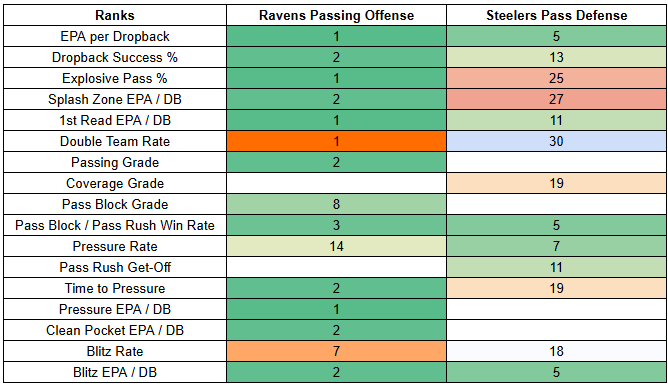
If Jackson is able to rebound in the rematch, he has a chance to recapture some of last week’s downfield magic. The Steelers have struggled with allowing explosives this year.
Like last week, we can’t count on receiving volume here. Jackson is also very unlikely to be as efficient as last week. But Jackson still has a good chance of being efficient by normal standards.
And we can count on Zay Flowers to have a strong role in a game where Jackson should play well. He’s a low-end WR2.

Last week, Rashod Bateman delivered a well-timed, fantasy-playoff spike week, and his deep 16.1 aDOT makes him a solid fit for this matchup as well. He’s a decent dart throw.
Mark Andrews scored yet another TD last week. Even better, he posted 82% route participation in a game where Isaiah Likely was at 57%. In games where Likely has played this year, Andrews had previously topped out at 75%. Andrews' playing time has bounced around this year, so it’s possible we see him back around 65% route participation this week. But Andrews has been productive on a per-route basis all season… we just need more routes. Last week’s usage was a bullish sign for his upside. He’s a low-end TE1.

The Steelers have faced Saquon Barkley, Derrick Henry, Bijan Robinson, Breece Hall, Jonathan Taylor, and (come on, he totally belongs) Rico Dowdle. None of those RBs – even Dowdle – hit 100+ yards. Only Tyrone Tracy, who turned 20 carries into 145 yards, has a 100+ yard performance against Pittsburgh.

This isn’t an ideal setup for Derrick Henry, but it’s not terrible, either. He posted 12 RYOE against Pittsburgh in their first meeting, and sits at 439 on the season — the second-highest mark on record. This is a tough matchup, but Henry is more than capable of delivering. He’s an RB1.

Back to Quick Links
Lions at Bears, 1 PM
Lions Implied Team Total: 27.5
Dan Campbell wants to win games. He might want to win… too much? That would explain last week’s wild onside kick, ordered up with 12 minutes left in a 10-point game. Still, we can reliably count on him to play the situation in front of him, rather than hiding behind style and tendencies. For the Lions, their style and tendencies are built around the run — but they showed last week they’re willing to adapt as needed.

The Bears aren’t the Bills. They are very unlikely to put the Lions into a deep negative game script that forces them to the air. But given the Lions major injury issues on the defensive side, it will be harder for them to win with a run-heavy approach. And that approach has lost a major contributor, with David Montgomery dealing with an MCL injury. Montgomery was a highly reliable runner.

For Jahmyr Gibbs, Montgomery’s absence creates major rushing volume upside. Gibbs wasn’t being used as a receiving complement—his 42% carry share on the season actually matches Montgomery’s. We can expect him to take over a big chunk of Montgomery’s rushing workload.

Even better, we can expect Gibbs to be a much bigger part of the passing game. Montgomery had an elite 24% TPRR, driven by a 31% TPRR on play-action.
Gibbs should now be a much bigger part of the traditional running game and therefore, a much bigger part of the fake running game. Play action is a huge part of the Lions attack – with Goff leading the NFL with a 35% play-action rate.

And Gibbs will be going against a Bears defense that is allowing the fourth most yards per game on play action. His expanded role in the passing game should pay off immediately.
The Bears are also weak against the run.

And the Bears are a run funnel. Most teams, including the Lions in Week 13, have leaned on the run against them.

And again, since Gibbs should see a boost in the play action game, an attack built around traditional run looks helps him. He’s an elite RB1.
In an ideal world, the Lions wouldn’t have to lean a ton on Jared Goff this week. But the last few weeks have been anything but ideal for the Lions, who have dealt with a devastating rash of injuries on defense. Caleb Williams showed an ability to put up points against the Lions on Thanksgiving, and should have an easier time generating production this week.
Fortunately for Detroit, the Bears’ defense looks far less formidable than it did to begin the year. They allow explosive passes at the highest rate in the league, and don’t protect the deep middle of the field well.

The Bears do still get pressure, though. And they pressured Goff 40% of the time on Thanksgiving, the second-highest rate he’s seen all season.
Pressure is a big deal for Goff, who’s generated an NFL-high 148 EPA from a clean pocket. When facing pressure, he becomes mortal, turning in -37 EPA. That’s still good, ranking QB6 — all QBs are much worse under pressure than when kept clean. But Goff can be deadly when kept clean, which could be harder for the Lions to achieve here.
Still, Goff was solid against the Bears on Thanksgiving. And outside of a few duds, he’s been very strong all year.

This isn’t a perfect setup for Goff, but it’s a pretty nice setup for his receivers. With the potential for increased passing volume as the Lions defense deteriorates, Amon-Ra St. Brown’s ceiling looks very strong. His ability to rack up targets makes him a safe option. But he’s also highly efficient per route. St. Brown is a high-end WR1.

Jameson Williams is a fun play here, as a bet against the Bears ability to contain explosive plays. He’s been impressively efficient this year and is a WR3.
Although Jahmyr Gibbs looks likely to be the primary beneficiary of David Montgomery’s vacated play action targets, it’s likely that Sam LaPorta benefits as well. He has a 24% TPRR on play action, so he’s been an important part of the attack.
What we don’t yet know is how much of the traditional rushing workload Gibbs will handle. And it’s possible that Craig Reynolds takes a meaningful chunk of that work. In turn, Reynolds would handle a chunk of the play action routes instead of Gibbs — a boon for LaPorta. LaPorta’s outlook is still far weaker than we assumed in August, but he’s a TE1 here.

Bears Implied Team Total: 20.75
When Thomas Brown took over as the Bears OC in Week 11, Caleb Williams’ efficiency spiked dramatically. But it’s been a downward trend since. And that trend has accelerated since Brown took over as interim head coach. Against the Vikings, Williams’ turned in a performance on par with his Eberflusian lows, when Shane Waldron was calling the shots.

The simple fact is that Caleb Williams has not been very good this year. Among the 34 QBs with 250+ dropbacks, he ranks QB27 in EPA per game and QB28 in success rate.

Williams has been especially bad under pressure. Only Will Levis has a higher pressure-to-sack rate. And Williams is creating issues for himself with a long time-to-throw, one of the more concerning data points in his recent efficiency decline. After tightening things up with an ultra-quick 2.42s TTT in Weeks 11-12, Williams has reverted to holding the ball. He posted a 3.41s TTT on Thanksgiving, a 2.86s mark against the 49ers, and then 3.28s in his dud against the Vikings.
Williams is probably going to hold the ball too long… which isn’t surprising given his playmaking playstyle in college. Brown can help by calling quick-hitting passes, but at the same time, Williams is who he is.

What Williams really needs is a matchup where holding the ball isn’t going to create major problems. And with the Lions’ defense ravaged by injuries, he should be able to get away with a longer TTT this week. Even before losing DL Alim McNeil – Detroit's best interior pass rusher – to a season-ending knee injury, the Lions pass rush was looking weak.

The main downside for the Bears passing game is that the Lions’ injuries have also made them easier to run on. The Packers and Bills both leaned on the run against them over the last two weeks.
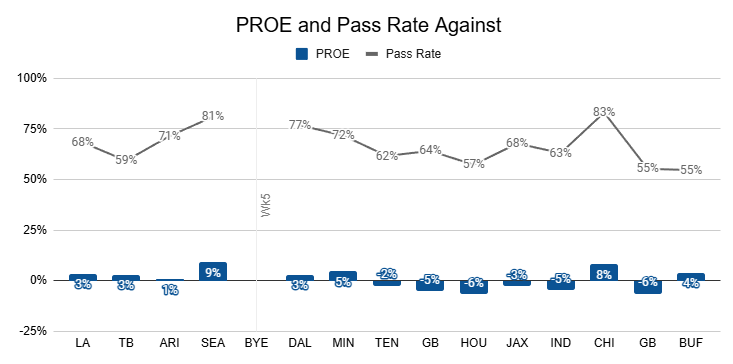
And the Lions aren’t great against the run.

We also have a Bears team that looks less interested in passing with Williams playing poorly. They fought against pass-oriented game scripts in each of the last two weeks.

This isn’t a pristine setup for the Bears passing offense. But it definitely looks like a good one. We can expect the Lions to put up points against them. And we can expect (or maybe hope) Williams to be more efficient than he’s been recently. It’s possible the Bears go overly conservative here, limiting volume. But there’s upside if they lean into an efficient passing day.
But we’re still dealing with the same issues in the passing game that we have been for most of the year. None of the Bears WRs are delivering efficiently. And Keenan Allen, the least exciting playmaker of the bunch, is arguably the best bet for targets.
Allen is coming off a 14 target game and is averaging 10.8 targets over his last four. DJ Moore isn’t far behind, though, with 9.8 targets over his last four. And he had 16 targets just three weeks ago.
With the potential for passing volume here, both look like WR2s.

Rome Odunze is the Bears’ big play threat, and this could be a spot where Williams can connect downfield. He’s riskier than the veterans, but still a WR3.
Cole Kmet continues to run a healthy number of routes with Brown in charge of the offense, but his target rate is very poor. He’s a dart throw.

With Roschon Johnson out for the last three games, D’Andre Swift has been carrying the load. Against the Vikings he handled 19 carries, his second-most of the year. But Johnson is back at practice, and could resume his goal line role in the offense. Swift has been a very disappointing runner this year, outside of the occasional chunk gain (he has five rushes of 20+). If Johnson returns, Swift is a big-play dependent low-end RB2.



